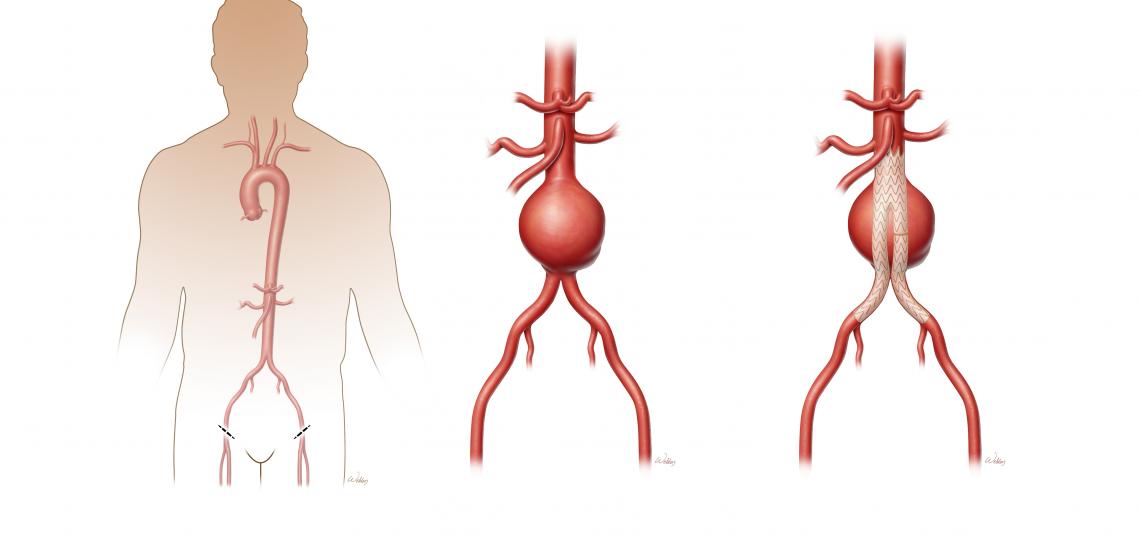Endovascular repair of abdominal aortic aneurysm (AAA). Incision sites (left), aneurysm (center), stent placed (right).
Your aorta is a tube-like structure that resembles a candy cane. The thoracoabdominal aorta starts after the curve of the cane and extends past the arteries that deliver blood to the stomach, intestines and kidneys.
An aneurysm refers to ballooning out of the aorta which causes aortic wall weakening. The aortic wall may continue to further expand or remain unchanged, but close surveillance is necessary. As the aortic wall weakens, there is a risk of the wall tearing or dissecting.
What Contributes to the Formation of an Aneurysm?
- Age and/or degenerative disease of the aortic wall
- Uncontrolled high blood pressure
- Long-term use of tobacco
- Inflammation or swelling of the aorta
- Infection
- Past medical history of connective tissue disorders, such as Marfan syndrome, Ehlers-Danlos syndrome or Loeys-Dietz syndrome
- Trauma
Diagnosis and Symptoms
Individuals with descending thoracic or abdominal aortic aneurysms usually do not have symptoms. Aneurysms are commonly found incidentally. It is possible that as the aneurysm enlarges and compresses surrounding nerves or organs, an individual may experience back or abdominal pain.
Patients that experience sudden symptoms such as chest or back pain, characterized as a tearing sensation, nausea, vomiting, a fast heartbeat and possibly the feeling of impending doom, may be experiencing a tear or dissection of the aorta. Left untreated this can lead to rupture and is considered an emergent condition that requires immediate intervention.
Computed tomography or CT scan with or without contrast is the most common imaging study used to evaluate your condition. A CT scan provides valuable information about your aorta, such as the location and size of an aneurysm or dissection. Magnetic resonance imaging (MRI) or magnetic resonance angiography (MRA) is another imaging modality to visualize your aortic aneurysm and vessels. Similar to a CT scan with contrast, an MRI or MRA provides detailed information about your aorta. Your surgeon will choose the best method for imaging your aorta.
Endovascular Repair of the Aorta
Endovascular means a procedure done inside a blood vessel. During this procedure, your surgeon will use x-rays for guidance and move a tube through a large blood vessel in your thigh to the aneurysm. A fabric tube, called a stent graft, is then placed inside the aorta to seal off the aneurysm and create a new path for blood flow.
After the stent graft is expanded, the delivery tube is removed, leaving the stent graft in place. Depending on the shape and size of your aneurysm, additional stent grafts may be added to fully seal the aneurysm. X-rays and/or ultrasound imaging are used to check that the graft is properly positioned.
The stent graft stays in the aorta permanently, secured by metal prongs or anchors and/or a tight fit against the aorta wall.
Before finishing the procedure, x-rays will confirm that blood flows through the graft, not the aneurysm. The small cuts in your legs are closed with a few stitches.
Recovery
It will take you approximately one month to fully recover from undergoing endovascular aortic aneurysm surgery. You should plan to be away from work, getting your full strength back, for approximately four weeks. Your surgeon will advise you on post-operative restrictions and when it's safe to drive again.








 Credit
Credit
